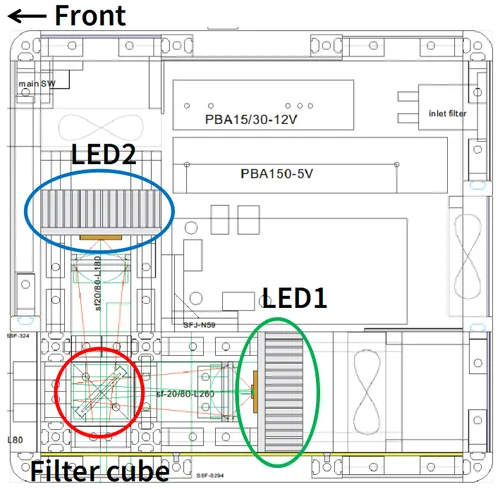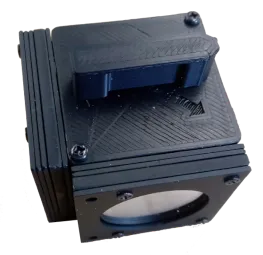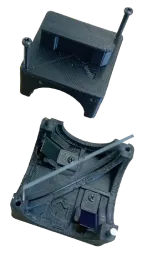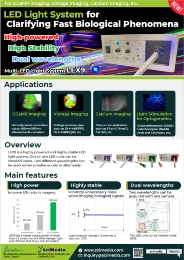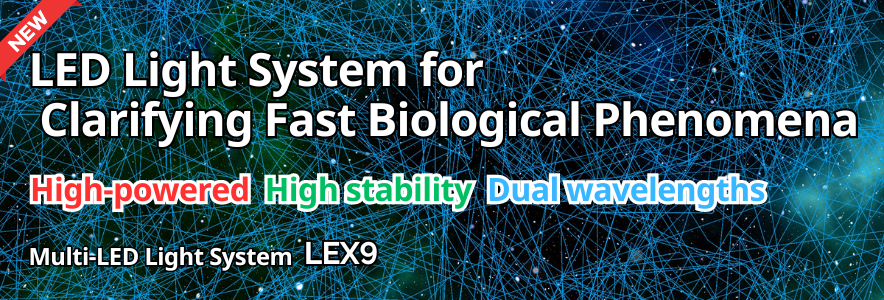
Multi-LED Light System LEX9
LEX9 is a highly powered and highly stable LED light system developed for biological research. Two different LED units can be installed inside. The LED units use LEDs in the visible to near-infrared light range that have higher output than conventional ones, and various wavelengths can be selected to match fluorescent probes.
It is possible to manually turn on/off one or two wavelengths, or alternately turn on two wavelengths in frame synchronization with a high-speed camera system. LEX9 is ideal as an excitation light source for high-speed fluorescence imaging.
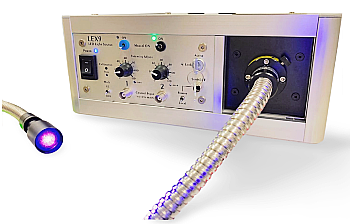
Applications
- GCaMP imaging
(Hemodynamic correction using 405nm/460nm) - Calcium imaging
- Voltage sensitive dye imaging
- Intrinsic optical signal (IOS) imaging
- Channelrhodopsin (ChR2)
- Halorhodopsin (NpHR)
- Arch and Chrimson, etc.
- Experiments requiring bright and highly stable light
- Experiments requiring wide area illumination
Main Features
- Higher power
- Improve S/N ratios
- Highly stable
- Minimize unnecessary noise when imaging biological signals
- Dual wavelength excitation
- Two wavelengths can be acquired with one camera
- Fast switching
- For high-speed imaging and pulsed light stimulation
- Expandability
- Compatible with various fluorescent probes
- Wide area illumination
- Illuminate entire area at low magnifications
Features
Higher power : Improve S/N ratios
The new LED chip has a higher output power of more than 4.3 times that of a commercially available 150W halogen light source and 1.8 times that of our old LED system.
LEX9 is essential for improving S/N ratios in wide-field imaging experiments where excitation light density tends to decrease and in high-speed imaging experiments where exposure times are short.
-
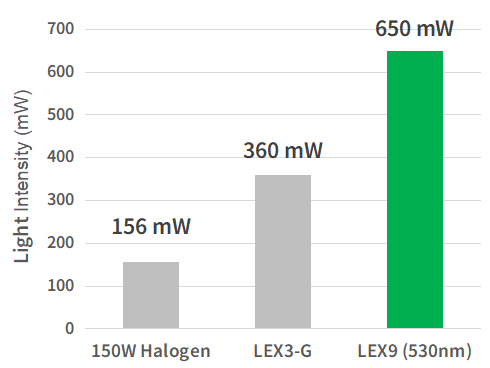 Comparison of brightness of three different light
sources.
Comparison of brightness of three different light
sources.
Wavelength is around 530nm and light intensity setting is 100%.
Left: 150W halogen light source (Uses 531nm bandpass filter)
Center: LEX3-G green LED light system
Right: LEX9 LED light system (530nm LED unit installed)
Highly stable : Minimize unnecessary noise when imaging biological signals
Generally, when an LED is turned on for a long time, light intensity decreases as the temperature rises. In the case of biological imaging, it is necessary to capture small changes in light intensity. However, drifting of excitation light can become a major source of noise. Although drift can be removed in some cases through software processing, it can also impair the accuracy of biological signals.
LEX9 is equipped with an optical feedback mechanism that monitors the intensity of the output light and keeps the intensity constant, minimizing drift.
-
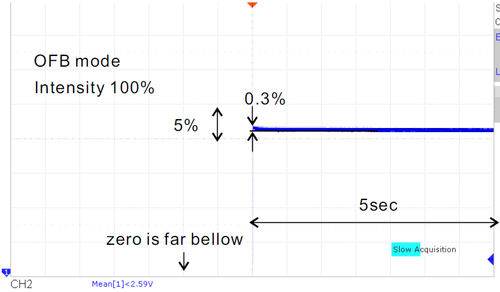 Light intensity change in 5 seconds is less than 0.3%
("OFB"=optical feedback)
Light intensity change in 5 seconds is less than 0.3%
("OFB"=optical feedback)
-
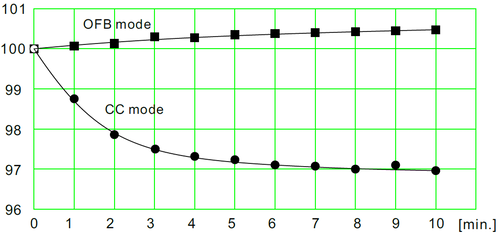 Light intensity change after 10 minutes is less than 0.5%
("OFB"=optical feedback)
Light intensity change after 10 minutes is less than 0.5%
("OFB"=optical feedback)
-
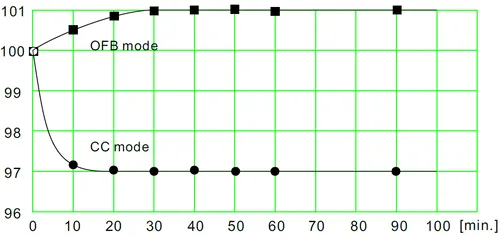 Light intensity change after 100 minutes is less than 1%
(“OFB"=optical feedback”)
Light intensity change after 100 minutes is less than 1%
(“OFB"=optical feedback”)
Dual wavelength excitation : Two wavelengths can be acquired with one camera
Two LED units can be installed inside LEX9.
Light from the two LED units is output from the same optical path/light guide via an internally
installed dichroic mirror. There is no need to prepare a separate beam splitter to connect to
the microscope.
It is ideal as an excitation light source for GCaMP imaging using 405nm and 460nm, as well as other dual-wavelength imaging experiments.
Fast switching : For high-speed imaging and pulsed light stimulation
Since no mechanical mechanism is used, such as a filter wheel, it is possible to switch between
two wavelengths at high speed. Even in applications where each frame is illuminated with
excitation light of a different wavelength, it is possible to increase the camera frame rate
more than ever before.
(Switching between two
wavelengths
requires an external pulse generator
or camera system that can output two types of pulse patterns.)
Expandability : Compatible with various fluorescent probes
It is possible to purchase additional LED units with different wavelengths. Therefore, customers can easily add or replace LED units by themselves. We are also planning to develop a white light LED unit.
-
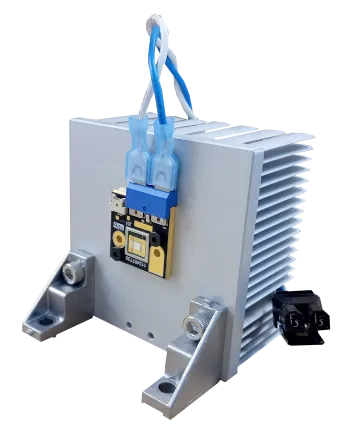 LED unit
LED unit
-
Center wavelengths of available LED units 405nm / 460nm / 530nm / 580nm / 620nm
(Option: 500nm / 730nm / 780nm / 875nm / 940nm)
-
 It is possible to change the wavelength by replacing the internal LED
unit.
It is possible to change the wavelength by replacing the internal LED
unit.
Fluorescence filters are held in a filter cube (shown in the image below).
Standard size φ25mm bandpass filters and 25mmx36mm dichroic mirror can be installed in the
filter cube, allowing customers to freely and easily replace the fluorescence filters.
Wide area illumination : Illuminate entire area at low magnifications
A φ10mm light guide is used as our standard light guide to brightly illuminate a wide area. Suitable for fluorescence imaging at low magnifications and wide fields of view.
Other features
Extremely short rise time (< 10μs) suitable for pulsed light irradiation
e.g. for optogenetics experiments using channelrhodopsin.
Automatic calibration function that sets the optimal light output conditions for each LED unit
No need to change internal settings even after changing the LED unit
Microscope adapter available (sold separately)
Can be connected to microscopes from various companies
Can also be operated with remote control (sold separately)
We also plan to develop an option that allows users to operate the system from a web browser on a smartphone or PC.
Optical properties
Wavelength characteristics of LED units
Wavelength characteristics of LED units and transmission wavelength range of bandpass filter
-
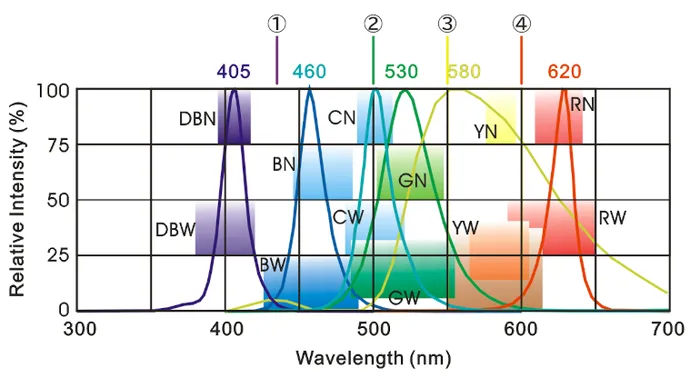 The wavelength characteristics of each LED are shown with each
intensity peak as 100%. Actual LEDs have a slight wavelength shift due to individual
differences. Therefore, it is not possible to compare the intensity of each wavelength
of different LEDs in the above figure. The transmission range of a bandpass filter is
expressed by the width of each color block. We propose two types of bandpass filters:
narrowband (N) and wideband (W) for deep blue (DB), blue (B), green (G), yellow (Y), and
red (R) LEDs. We recommend bandpass filters with a thickness of 3.5mm.
The wavelength characteristics of each LED are shown with each
intensity peak as 100%. Actual LEDs have a slight wavelength shift due to individual
differences. Therefore, it is not possible to compare the intensity of each wavelength
of different LEDs in the above figure. The transmission range of a bandpass filter is
expressed by the width of each color block. We propose two types of bandpass filters:
narrowband (N) and wideband (W) for deep blue (DB), blue (B), green (G), yellow (Y), and
red (R) LEDs. We recommend bandpass filters with a thickness of 3.5mm.
Recommended optical filters
If only one wavelength is used, a broad bandpass filter can be selected. If two wavelengths are used alternately or simultaneously, a narrow bandpass filter can be selected so the transmitted wavelengths do not overlap.
Filters not listed below can be used as long as they are standard sizes (φ25mm bandpass filter and dichroic mirror of approximately 25mmx36mm).
| LED unit | Name | Code | Application | |
|---|---|---|---|---|
| (A) 405nm | Narrowband BP405nm | DBN405/20c | Autofluorescence, GCaMP (for control), others | |
| ① | Dichroic mirror DM435 | DM435e | (A) // (B)(C)(D)(E)(F) | |
| (B) 460nm | Narrowband BP466nm | BN466/40e | GCaMP, ChR2 | |
| Wideband BP460nm | BW460/60s | FITC, Fluo-4, FluoVolt, others | ||
| ② | Dichroic mirror DM495 | DM495e | (A)(B) // (C)(D)(E)(F) | |
| (C) 500nm | Narrowband BP500nm | BN500/24e | ANNINE-6 | |
| Wideband BP503nm | BW503/40s | |||
| (D) 530nm | Narrowband BP525nm | GN525/45e | RH237, Rhod-2, others | |
| Wideband BP520nm | GW520/70e | Di-4-ANEPPS, Di-2-ANEPEQ, others | ||
| ③ | Dichroic mirror DM552 | DM552w | (A)(B)(C)(D) // (E)(F) | |
| (E) 580nm | Narrowband BP586nm | YN586/20w | NpHR, others | |
| Wideband BP585nm | YW586/40e | |||
| Wideband BP582nm | YW582/64s | |||
| ④ | Dichroic mirror DM605 | DM605e | (A)(B)(C)(D)(E) // (F) | |
| (F) 620nm | Narrowband BP628nm | RN628/32e | RH-1691, Di-4-ANBDQBS, others | |
| Wideband BP620nm | RW620/60e |
Specifications
| Item | Description | Memo |
|---|---|---|
| Model | LEX9 | |
| Name | High-powered Multi LED Light System LEX9 | |
| LED unit | ||
| Center wavelength | 405nm / 460nm / 530nm / 580nm / 620nm (Option: 500nm / 730nm / 780nm / 875nm / 940nm) |
- Width of output wavelength depends on the bandpass filter used together. - Please contact us for wavelengths not listed. |
| LED intensity at 100% setting | 405nm: 407mW/cm2 460nm: 1,833mW/cm2 530nm: 650mW/cm2 630nm: 1,057mW/cm2 |
Depends on the transmission rate of the bandpass filter used together. |
| Number of LED units that can be used simultaneously | 2 | |
| Number of built-in filter cube | 1 | 2 excitation filters / 1 dichroic mirror |
| Compatible excitation filter | 25m diameter, 3.5mm thickness | |
| Compatible dichroic mirror | 25mmx36mm | |
| Main body | ||
| Intensity control | Manual control, or Remote controller (sold separately) |
We also plan to develop an option for users to operate the system from a smartphone or PC web browser. |
| Lighting control | Manual control: key switch on the front panel External control: triggered by over 1.5V input |
|
| Lighting mode | CC (constant current) mode OFB (optical feedback) mode |
Ideal for pulsed light irradiation Ideal for normal use |
| Drift of light intensity | < 0.3% (5 sec) < 0.5% (10 min) < 1.0% (100 min) |
with OFB mode |
| Rise time | < 10μs | with CC mode |
| Frequency characteristic | <= 100kHz (10μs) @ CC mode <= 20kHz (50μs) @ OFB mode |
|
| Intensity stabilization system | PD feedback circuit | |
| LED protection system | Overcurrent suppression circuit and overheat suppression circuit | |
| Cooling method | Heat sink and electric fan | |
| Safety mechanism | Operation control by key Interlock system (light guide connector ) Manual reset after optical output is cut off Emergency stop switch (optional) |
|
| Recommended light guide (sold separately) |
For epi-illumination: Moritex MSG10-2200S For side illumination: Moritex MSG10-2200S |
Please contact us for other light guides. |
| Microscope adapter (sold separately) |
Brainvisin's Fluorescence Mesoscope Fluorescence microscopes manufactured by Olympus/Nikon/Leica/Zeiss |
|
| Environmental Conditions | Indoor use, temperature 0℃ to 35℃ Humidity 0 to 70% | |
| Dimensions / Weight | 300mm(W) x 350mm(D) x 130mm(H) / 7.3-7.6kg | |
| Input Voltage / Power Consumption |
100V-220V 200W | |
* This product is made in Japan. * This product is for research purposes only.
Flyer Download
-
High-Powered LED Light Source LEX9
